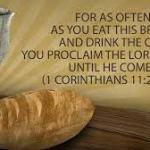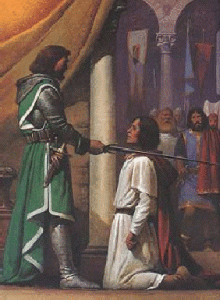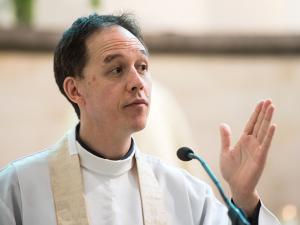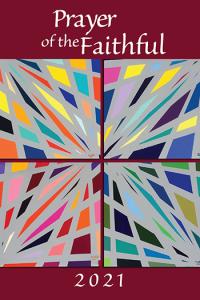Celebrations of Grace: The Sacraments of the Catholic Church, Part 16

The sacrament of Matrimony teaches us to look at sacraments in a new way. Take a common definition of sacrament: effective sign of God’s grace. We’re talking about signs that contain or effect what they signify. Words are a bit fluid here, but often, people say, “symbol” works better than “sign” for this reality. The sign, or symbol, of Matrimony doesn’t quit when the couple walks out the church door.
The married couple is a living, and conspicuously effective, sign of God’s love. That thought got me thinking about the other sacraments. Holy Orders, of course, is like Matrimony in that the sign of priesthood continues throughout a priest’s ministry. But the other sacraments are at least somewhat similar. The baptized, nourished, forgiven, and healed person, is also a sign of God’s love. Sacraments don’t quit, and grace remains effective in the Christian as sign of God’s love. But there’s a difference with these latter sacraments.
Early in this series, I said that God’s gracious presence is not hidden under sacramental signs. The whole point of these signs – and the new forms of the liturgy make it especially plain – is to show God’s love with a clarity that it does not have elsewhere. We see God’s love operating continually; but, on the face of it, it just looks like a welcoming smile, a word of encouragement, a healing touch. By itself it doesn’t speak of Baptism, Confirmation, Anointing of the Sick. But the married couple does say “marriage” without even speaking, as the ordained person says “priest.”
Faithful and forever
A marriage is a lasting reality and a lasting sign. As signs, all the sacraments tell us something about God’s love. Baptism, Confirmation, and Eucharist tell us that God’s love is welcoming, life giving, strengthening, and nourishing. Reconciliation and Anointing of the Sick tell us that God cares for us in our weakness, our suffering, even in our sin. The sacrament of Matrimony tells us that God’s love is faithful and forever.
It’s hard to comprehend a love as faithful and enduring as we are told God’s love is. It becomes much easier to believe it when we have the example of faithful marriages and families. This is so important that, according to Catholic teaching, if it’s the sacrament of Matrimony, it has to be until death. Married couples are both signs of God’s love and instruments, bringing God’s love to each other and the world around them.
Echoing God’s freedom
The world calls marriage a “tie that binds” and often misses the important point. Entering into Matrimony is a free act that echoes the absolute freedom with which God created the universe. Nothing was missing in God. God did not need anything. God’s choice could have been different, and we wouldn’t have existed. But this first, creating choice binds God to other beings forever in an absolutely selfless love. That doesn’t limit God. God’s being bound now continues the awesome freedom of that original choice to create.
Two mature people, confident of their individual strengths and their love for each other, commit themselves freely by a permanent vow. Later to grow tired of it and break that vow is not a step toward greater freedom; it is a denial of freedom.
Human freedom is not absolute like God’s. Human love is never absolutely selfless. But the Church claims that human beings with God’s help can make free choices that are like God’s. You don’t ever take them back. They last until death. Freely making this permanent commitment to another defines a Catholic marriage.
Love expands its reach
Marriage would be a poor imitation of God’s creative freedom if a couple deliberately bestowed their love and their commitment only on each other. The circle of their marital love breaks open, reaching out to new human life and to the community around them. The married couple and the family are people on a mission—to one another, to generations that follow, and to the whole world.
No sacrament is private. Because matrimony is a sacrament, because married love reaches out to all life, and most of all because people who commit themselves in marriage reflect to the whole community God’s free, creative, and faithful love, the celebration of matrimony is not a private affair. The celebration most fittingly takes place where the community gathers. Destination weddings get this important point all wrong.
In this scene in Fiddler on the Roof, an intense and radical Perchik asks Hodel, Tevye’s second daughter, a “political” question. It’s his clumsy way of asking her to marry him. In the audience we laugh, but there’s a point. Marriage is good for societies. It’s a benefit to the country, in recognition of which countries have laws regulating marriage.
Matrimony is a state of being as well as a ceremony. This sacrament is never over, and the signs of this sacrament include all the ways married people show the faithfulness of God’s love in their love for each other, in their willingness to dedicate themselves to the raising of children, and in their service to their society and their world.
Even when a husband, wife, daughter, or son acts alone in performing some service, it’s the act of a member of a family and a commitment that the whole family shares. There are many ways the sacrament of Matrimony shows us God’s faithful love.
Celebrating the sacrament of Matrimony
The sacramental sign that is unique to the sacrament of Matrimony is the public exchange of marriage vows. With these words the marrying couple give the sacrament to each other in the presence of a priest or another community-designated official and the supporting community.
The sacrament of Matrimony is for all of us, whether we are married or not, part of a loving family or not, touched by love in its myriad ways or wishing we were. All those ways of love are what people celebrate when they gather to celebrate the sacrament of Matrimony.
In a future post I will argue that the grace of the sacrament of Matrimony saves sex.
Image credit: www.cclo.org via Google Images












